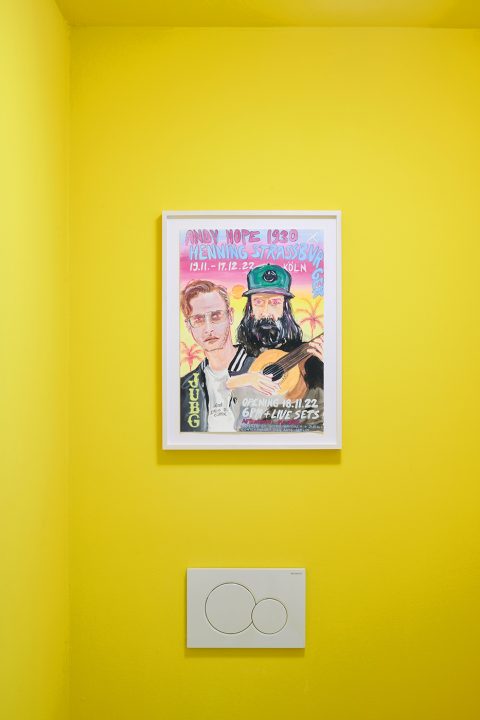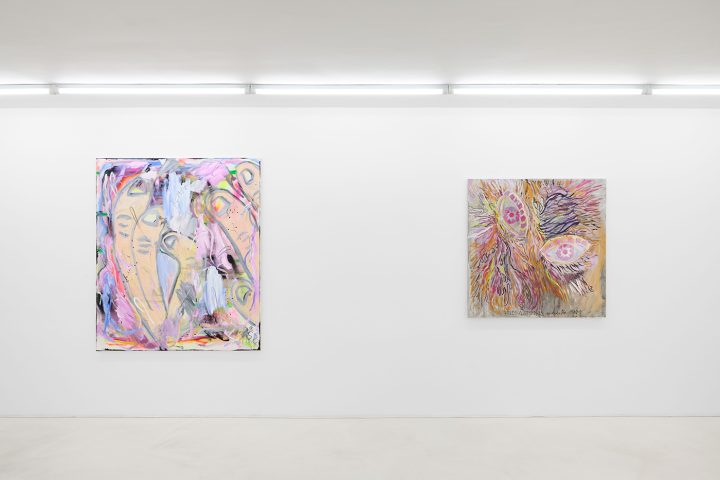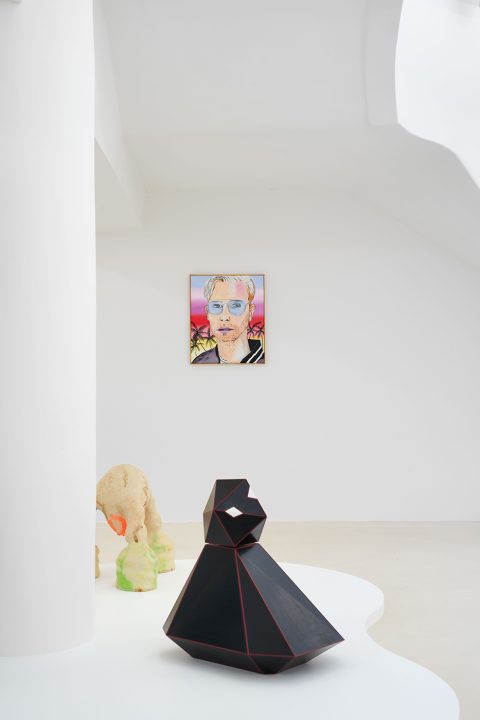Andy Hope 1930 & Henning Strassburger
November – December 2022
Installation Views






















From Disco to Disco
When Henning Strassburger was a child, back in the 1990s, he sat at home in front of the TV. “I am one hundred percent generation music television. To me, music and image, music and video are inseparable”, says the now 39-year-old, laughing. That’s one of the reasons why Strassburger has been keen to exhibit at JUBG, and when people say that his art examines the possibilities of classical / analog painting in a society flooded with digital imagery, it’s not just Instagram or TikTok that comes to mind, but rather about 100,000 videos the painter binged on in his youth. The Portrait of the Artist as a Young Man would be a teenager in socks in the parental living room, watching MTV with reheated food on his lap. Smells Like Teen Spirit. The self-portraits as a pimply Justin Bieber, an aging Las Vegas star, or Pete Doherty are distant reminiscences of it, simultaneously illustrating the distance that these things have to him today. Bieber wasn’t even born when Strassburger watched music videos in Meißen.
Therefore, the pop star in Strassburger’s portrait has the pimples on his face that the painter himself may have had in the past. That makes Bieber just a bit ugly – which is a little mean – brings him down to earth and robs him of some of the charisma that has surrounded all great pop stars since Jesus Christ. The hero in decay. Decay is also the first thing Strassburger mentioned about Pete Doherty when we were talking. “Have you seen how fat he’s gotten when he exhibited his paintings in Berlin just now? Guy only has three teeth left in his mouth. Everything in pop has its momentum. Take Britney Spears, she’s been riding the same wave for twenty years. But Doherty’s time – his little peak around the year 2000 when I was young and he was with Kate Moss – that’s over.” Strassburger puts this distance into the picture by lending his present-day face to yesterday’s idol. His Doherty is a portrait in decline. A ruin or an allegory, as Walter Benjamin would have said: An image that references something lost and at the same time brings this loss into the image, simultaneously saving and revealing something. The self-portrait as an aging Las Vegas star is similarly melancholic, although it places the references even further back in time. After all, the days when Las Vegas produced stars who then grew old are long gone, tempi passati. The allegory represents the past, but not continuity. Its references are arbitrary. This arbitrariness in the reference is essential for pop and its play with the mythology of the present, in which of course references can then be made loosely.
This is also visible in the works of Andy Hope 1930, who is exhibiting with Strassburger and whose portraits in contrast almost exclusively depict non-human beings. The series Heedrahtrophia, from which three portraits are presented in the exhibition, takes a monster from Japanese pop culture of the 1970s and transfers it to the present. In the movie Godzilla vs. Hedorah (1971), Hedorah is a tiny alien feeding on exhaust fumes and pollutants. It arrives on Earth and finds so much food there that it grows into a huge monster, threatening to destroy humanity. However, Godzilla can defeat it in the final battle. Andy Hope 1930 portrays this alien as a multifaceted environmental monster – in toxic colors, with dissolving contours, shimmering surfaces, and abstract forms. The portraits not only depict a monster, as writer Sarah Khan once remarked, but they are also monstrous themselves, confronting us with the sheer, beguiling and disturbing violence of painting. The artist succeeds in this because he does not simply imitate pop culture, but transforms it artistically by incorporating the formal language of avant-garde art into its depiction. These include e.g. suprematist color fields like in the portrait Number One (2019), which shows the only human face with the figure of the first officer of the spaceship Enterprise, or surrealistic elements like in the portrait Dark Times (2014), which shows a female figure composed of different elements. The hair is taken from an underground comic, perhaps by Robert Crumb, the eyes are a collage – like the lettering on the forehead – and the lips are painted. The sculptures are created similarly. Two 4000 (2017) is some sort of robot made of Malewitsch forms. The Disappeared I and The Disappeared II (2018) transform machines the artist encountered in a 1960s science fiction story into surreal sculptures. However, they retain a remnant of functionality, or rather the appearance of it, and could equally look at home on display at a technology museum as in a gallery setting. There, of course, they would be looked at differently, not primarily aesthetically, but teleologically. The question would then not be: Is it beautiful? But rather: What is it good for? This openness of the works points to the power of the institutions that host them. For Andy Hope 1930, revealing power relations is part of the political and critical claim of his work. Not only do they bridge the gap between higher and lower art, pop culture, and avant-garde “Cross the Border – Close the Gap.” – but also between science and art. For example, the sculpture Squidgy 3-Leg (2017) is based on scientific studies about what life might look like on a planet that differs greatly from Earth and, for example, has a much stronger gravity. The creatures would then have to live much flatter; they would also be smaller and perhaps would not have developed an upright gait like we humans did on Earth, and would therefore also have had a different mental and psychological development. Maybe they would look like Squidgy 3-Leg. Then again, maybe they wouldn’t – because Andy Hope 1930 didn’t build a scientific model, but created a sculpture. This sculpture gives the parameters calculated by science a shape – which may even remind some of you of something familiar like it reminds me of the swamp monsters from horror and science fiction films – but it dissolves this shape yet again into more abstract forms. The sculpture thus oscillates between scientific model and artistic form. The painter calls his work on motifs and figures of – mainly American – pop culture “American abstraction”. However, they can also be described using the term grafting, borrowed from botany, i.e. placing a branch on a foreign stem. The philosopher Jacques Derrida used this term in the arts to describe what happens when a word or sign is placed or quoted in a different context. Because, just as in botany, the stem nourishes the branch and the branch grafts the stem, the quotation also changes its new context and the context changes the quotation. However, Andy Hope 1930 does not quote the forms and figures but really brings them together like stem and branch. He grafts a figure from pop culture onto the stem of avant-garde art, or vice versa: the formal language of avant-garde art onto the stem of American pop culture. And just as in botany, both nourish and transform here. The pop figure nourishes the avant-garde form. The avant-garde form transforms the pop figure in return – just as with Heedrahtrophia, which gains its monstrous effect in particular from the way it is painted – and the figure transforms the form – as in Number One, whose suprematist design only becomes visible at the second glance, because one at first only recognizes a specific human face.
Both artistic positions show complementary forms of art and pop and thus reflect its history. Firstly, there is Andy Hope 1930 with his playful works, their labyrinthine references, and artistic transformations, which follow the avant-garde principle of difficult reception and reveal power relations. On the other side there is Strassburger, who as a student admired his older colleague but now detaches himself from him with his light, self-deprecating portraits, which – like a pop song – are tailored to please at first sight, so that, as said by the artist, they can be distributed and marketed smoothly. In a record store, their work would be situated in different sections: alternative rock or electro. The musical interludes, which both artists perform in the third room of the gallery, fit in with this: the mixture of delta blues, psychedelic folk, and disharmonies by Andy Hope 1930, informed by the modernist composer Charles Ives, and the disco song Boi future, which Strassburger produced with Eric D. Clark.
One important commonality of the artistic positions is their reference to time. It is insightful not only regarding the works but also with regard to what these works reveal about the relationship between art and pop. Naturally, both artists design this reference differently. Andy Hope 1930 brings partially forgotten pop culture motifs into the present by transforming them with avantgardistic artistic means. Strassburger’s images, on the other hand, fall back from the present into the past, fleeting and dissolving into the countless series of similar images before them. In an interview, the artist once described this experience by using the example of a beach that he could no longer look at without thinking of the countless beach pictures he had already seen before. Digital media play an important role in this, because they infinitely multiply the number of these images, give them a special form and make us accustomed to immediately tagging and categorizing what we see with the respective hashtag. Just as the image we have in mind when we see a beach dissolve into the infinite series of beach images, Strassburger’s self-portraits as a pop star dissolve into the infinite series of celebrity portraits we’ve known since MTV. Unlike the works of Andy Hope 1930, they do not bring to mind the past, but rather convert the present to the past. With this explanation, the images take on an enigmatic character. Their mystery corresponds to the mystery of the moment, which is a central figure of pop and which the church father Augustine, ancestor of the debate, described as the mystery of time. After all, according to Augustine, he could not say at all what time was, because time cannot be held fast, but is constantly striving towards non-being. What has passed is no more. What is to be in the future is not yet, and what is present, the moment, vanishes again – like Strassburger’s pictures – and dissolves into the past. In the famous eleventh book of his Confessions it is said: “What, then, is time? If no one asks me, I know; if I want to explain it to a questioner, I do not know; with confidence, however, I can at least say that I know that if nothing passes away, there is no past time, and if nothing arrives, there is no future time, and if nothing existed there would be no present time. Those two times then, past and to come, how are they, seeing the past now is not, and that to come is not yet? But the present, should it always be present, and never pass into time past, verily it should not be time, but eternity. If time present (if it is to be time) only comes into existence, because it passes into time past, how can we say that either this is, whose cause of being is, that it shall not be; so, namely, that we cannot truly say that time is, but because it is striving towards non-being?”
Striving towards non-being – Strassburger’s paintings do the same. And just as Augustine says of the present that it actually has no space, the same could be said of Strassburger’s paintings, which shift from physical to virtual space as they dissolve into our visual memory. At the same time, with this endless series of images, they evoke an idea of eternity that points beyond the finitude in which we look at them. From this grows what Walter Benjamin called an aura. A glow around the edges that gives the appearance of transcendence. The works of Andy Hope 1930 also shine auratically. By snatching the almost-forgotten figures of pop culture from the virtual space of our memory and using artistic means to give them a physical reality and presence again, their aura is not that of an endless act of passing, but that of an eternal present in which nothing disappears.
With their aura, the works of Strassburger and Andy Hope 1930 subvert the common distinction between high and popular art and raise the question of whether it is not possible for pop to be auratic at all. Because if pop is the art of the present, as Rolf-Dieter Brinkmann once remarked, but this present evaporates into the endless series of the no-longer, as Augustine and Strassburger show, then pop is the art of an enigmatic present, which, just like time, has no space. To the question that Henning asked me to answer en passant in the exhibition text, namely, what pop is, I would give the same answer that Augustine gave to the question about time: “If nobody asked me about it I know, but if I have to explain it to someone who asks me, I don’t know.”
Björn Vedder, November 2022
